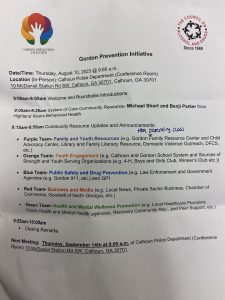Evaluation
Social workers must continue to evaluate their services and service delivery to ensure that clients are receiving the most current evidence-based interventions. I am committed to using evidence-based strategies that are current and are proven to be effective with the population I am serving. I will continue to evaluate the effectiveness of my client outcomes to determine what was effective or what needs improvement. I understand that evaluation is an essential part of being a service provider as it ensures my efficiency to address the need of my clients.
Practice Behaviors:
9A- Select evidence-based evaluation strategies according to their efficiency with specific client systems
Course Evidence: In the course Advanced Administrative Practice: Program Development, my group and I developed a plan to evaluate our program’s effectiveness. The program focused on Building Stronger Parents through evidence-based strategies that affected Tunica, Mississippi at a micro, mezzo, and macro level. One of the strategies used was found in the Program Evaluation Toolkit created by Stewart and his team (2022). Specifically, we selected the logic model to use as a planning and evaluation tool. The logic model offers a clear and continuous method for establishing a logical flow of a program and serves as a tool for identifying progression towards program goals. The logic model we created can be found in Appendix D on page 46. To learn more about the evaluation methods for the Building Stronger Parents Project, please click here and redirect to pages 29-31.
Field Evidence: I have been a part of the Gordon Prevention Initiative in Gordon County, GA. This organization focuses on improving the community by advocating for a safe, empowered, and drug-free environment for youth. I have met with this group monthly to discuss what other community organizations are implementing to support the mission. This meeting also involves reviewing current and previous data on how effective the community services were. Due to the increase of the Spanish population, I have joined a new task force that enforces culturally responsive methods for evaluation of services. This task force is still in the planning stages.
Below you will see some of the data the Gordon Prevention Initiative refers to along with an example of the most current agenda.


9B- Evaluate the efficiency and effectiveness of practice outcomes across systems
Course Evidence: In the course Advanced Clinical Practice: Individual and Family, I was able to reflect on my growth as a clinician. I had a CBT session with a client who I needed to build trust with and educate on the therapeutic process. With the CBT self-analysis paper, I identified key areas that could be improved and acknowledge my strengths. Self-reflection was used to improve the effectiveness of my service delivery.
Click here to view the CBT self analysis paper. Please refer to the second paragraph on page 1 to read about specific areas of improvement.
Field Evidence: Due to the compulsory education law, attendance is mandatory for students between the ages of 7 to 16 in Georgia state. As a district, it is important to review the student body attendance and compare it’s data to the previous year. Having graphical data allows social workers to identify patterns within students and/or families and apply these findings to review/improve the current intervention methods for attendance. I have reviewed this data with the district’s social workers and have assembled early intervention strategies that could improve the outcome for next school year.
To view the Calhoun City School’s attendance intervention plan please click here.
One of the attendance interventions is to hold an Attendance Review Team meeting (ART). An ART includes the social worker, student, parent, teacher, counselor, and any other staff member that has developed a relationship with the student. During this meeting, the attendance policy is reviewed and concerns are shared with all parties to initiate a plan to improve the student’s attendance. I have found that an ART can be ineffective among some students. The pictures below exemplify a student who did not respond well to an ART. Last year, the student missed 61 days of school. This school year, the student has already missed 11 days out of 26 scheduled days. As you can see, the intervention used last year was ineffective and the intervention used this year will be determined based on how the student responded to last year’s ART.


Skills Used: I used social skills, communication, collaboration, advocacy, and empathy to fulfill this competency.
Knowledge Used: I used knowledge from the Calhoun City School attendance policy, the course Advanced Clinical Practice: Individual and Family, the course Advanced Administrative Practice: Program Development, and Gordon Prevention Initiation information meetings.
Values Present: Service, social justice, competence, importance of human relationships.
Cognitive Process Used: I used comprehension and evaluation in this competency. I explained and supported families through the learning activities.
Affective Process Used: I participated and attended meetings with my groups, community task force, and attendance meetings.
Theoretical Foundation Used: I used the Perceptual Contrast Effect theory in this competency. I compared and contrasted several pieces of information to advocate for my clients.
